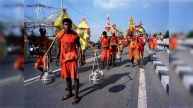Following the Pahalgam attack, helicopter services have been suspended for this year’s Amarnath Yatra due to security reasons. Union Home Secretary Govind Mohan arrived in Srinagar on Tuesday to oversee the security arrangements for the Amarnath Yatra, which is set to commence on July 3. In a move to enhance safety during the pilgrimage, the Jammu and Kashmir government has declared the Amarnath Yatra routes a ‘No Flying Zone’ from July 1 to August 10.
This is the first time since helicopter services began for the Amarnath Yatra that pilgrims will not have flying facilities up to the Holy Cave on both the Pahalgam and Baltal routes. The declaration, issued by the Jammu and Kashmir Home Department under the orders of Lieutenant Governor Manoj Sinha, prohibits the flying of all types of aviation platforms, including drones, UAVs, and balloons. However, exceptions will be made for medical evacuations, disaster management, and security surveillance, with detailed Standard Operating Procedures (SOPs) to follow.
As part of the preparations, Union Home Secretary Mohan is chairing a review meeting at the Jammu and Kashmir Police headquarters in Srinagar with key officials, including JK Chief Secretary Atal Dulloo, DGP Nalin Prabhat, and senior officers from various security agencies. The meeting aims to discuss the current security landscape in Jammu and Kashmir and finalize additional logistical provisions for a smooth and peaceful Yatra.
This year’s pilgrimage will last for 52 days, concluding on August 9, and will see devotees traveling to the revered cave shrine located at an elevation of 3,888 meters. Pilgrims can choose between two routes: the traditional Pahalgam route, which takes approximately two to three days, or the shorter Baltal route that allows same-day return after darshan.
In light of recent security concerns following the Pahalgam terror attack, authorities are implementing a robust multi-layered security framework involving the Army, Central Armed Police Forces (CAPFs), and JK Police. Comprehensive measures include a Face Recognition System (FRS), RFID tracking for pilgrims, real-time weather alerts, emergency evacuation protocols, and dedicated health camps to ensure the safety and well-being of all participants.
Also Read: Amarnath Yatra 2025: Pilgrimage Routes Declared ‘No-Flying Zones’ Amid Drone Threat – Check Details












